Wednesday, 21 May 2008, Verdun to Metz
(Written 22 May 2008)
After another tasty Hotel St. Paul breakfast, we set off for Metz, going the long way 'round via Étain, Longwy, Thionville, and the Maginot line. David especially wanted to tour one or more of the forts on the Maginot Line, which apparently dwarfed places like Douaumont. They were described as "underground cities," and tours were billed as using amunition elevators to lower visitors into them and then loading them onto little trains to move them around the place.
Our first stop was the Fort de Vaux. Unfortunately, when we got to it, we found the gift shop open, and a prearranged tour group was just starting its tour, but individuals like us who want a tour have to show up at 3 p.m. on a Sunday. Drat. So we walked around and took pictures of the wild flowers (below). Barn swallows (I think; forked tails, red chins) were flying around, and we could hear a cuckoo.
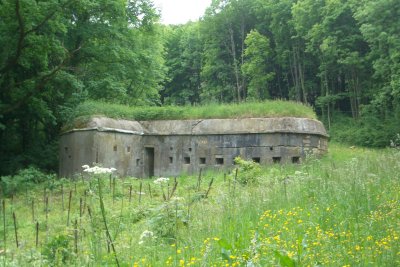 Next, we tried to visit the Fort de Fermont, one of the largest on the Maginot line, but we found it closed and shuttered. To tour it, we would have to show up at 3 p.m. on the first or third Sunday of the month, so we took a photo of the small blockhouse that guarded its rear approach before continuing our tour. At Longwy, we made our nearest approach to Luxembourg (about 2 km) and began looking for lunch. We finally found some at Le Bar des Supporteurs, i.e., "the (Sports) Fans' Bar," in Ottanges. They had only two kinds of hot sandwiches left, "ciabbatinos" and "hot dogs," so we opted for the former, which were actually delicious: a split baguette toasted, spread with some sort of herb mixture, topped with chopped ham and mild cheese, and run under the broiler. David tried Bofferding, the local beer from Luxembourg, and pronounced it "a pleasant pilsner."
Next, we tried to visit the Fort de Fermont, one of the largest on the Maginot line, but we found it closed and shuttered. To tour it, we would have to show up at 3 p.m. on the first or third Sunday of the month, so we took a photo of the small blockhouse that guarded its rear approach before continuing our tour. At Longwy, we made our nearest approach to Luxembourg (about 2 km) and began looking for lunch. We finally found some at Le Bar des Supporteurs, i.e., "the (Sports) Fans' Bar," in Ottanges. They had only two kinds of hot sandwiches left, "ciabbatinos" and "hot dogs," so we opted for the former, which were actually delicious: a split baguette toasted, spread with some sort of herb mixture, topped with chopped ham and mild cheese, and run under the broiler. David tried Bofferding, the local beer from Luxembourg, and pronounced it "a pleasant pilsner."
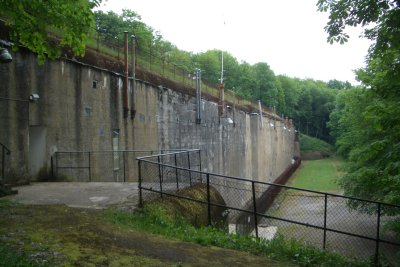 At our next stop, the Fort de Guentrange (its rear entrance shown here), the story was the same. Guided tours and access to the museum at 3 p.m., second and fourth Sundays from April to November. We hear that some of the forts further east are open more of the time, but we're not sure we'll have time to get to them.
At our next stop, the Fort de Guentrange (its rear entrance shown here), the story was the same. Guided tours and access to the museum at 3 p.m., second and fourth Sundays from April to November. We hear that some of the forts further east are open more of the time, but we're not sure we'll have time to get to them.
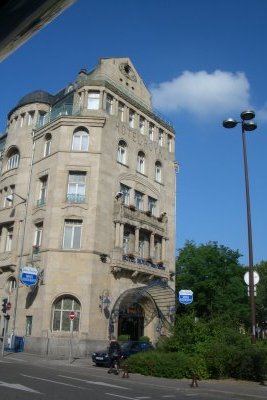 In Metz, we were booked into the Hotel Royal, on avenue Foch, which looked reasonably easy to find, but we didn't have an "intermediate" map that showed the transition from the highway (on the big regional map) to the city map. Of course, we wound up in the wrong lane and were shunted off our intended route and over a bridge. It took a while, but we bushwhacked our way back and found avenue Foch, complete with little signs directing us to various hotels, but ominously, none of them was for the Hotel Royal. We cruised up the six-block-long avenue and back four times without spotting it, even after narrowing the zone of where it could be by the street number. Finally we just pulled into a side street and parked. David stayed with the car (and quite visible luggage) while I went exploring. Seems it's been chain-ified and is now the Hotel Royal Bleu Marine. We'd seen the big windows marked with the Bleu Marine insignia, all sporting large "to let" signs, but the entrance to the hotel (the only part where the name "Royal" appears) is on the corner of the building, where a side street makes makes an acute angle with the avenue. That facade was facing away from us as we drove by the hotel in one direction and was on the other side of a densely planted median coming the other way. The "to let" signs are advertising for a client to come occupy the hotel's now empty restaurant space.
In Metz, we were booked into the Hotel Royal, on avenue Foch, which looked reasonably easy to find, but we didn't have an "intermediate" map that showed the transition from the highway (on the big regional map) to the city map. Of course, we wound up in the wrong lane and were shunted off our intended route and over a bridge. It took a while, but we bushwhacked our way back and found avenue Foch, complete with little signs directing us to various hotels, but ominously, none of them was for the Hotel Royal. We cruised up the six-block-long avenue and back four times without spotting it, even after narrowing the zone of where it could be by the street number. Finally we just pulled into a side street and parked. David stayed with the car (and quite visible luggage) while I went exploring. Seems it's been chain-ified and is now the Hotel Royal Bleu Marine. We'd seen the big windows marked with the Bleu Marine insignia, all sporting large "to let" signs, but the entrance to the hotel (the only part where the name "Royal" appears) is on the corner of the building, where a side street makes makes an acute angle with the avenue. That facade was facing away from us as we drove by the hotel in one direction and was on the other side of a densely planted median coming the other way. The "to let" signs are advertising for a client to come occupy the hotel's now empty restaurant space.
Once comfortably settled into our first-floor (American second floor) room (while the elevator still worked—it's been out of service ever since, but we hope it will be working again by the time we have to get our luggage back down the stairs), and our car safely stashed in the parking garage under the train station, a block away, we went for a stroll to check out the neighborhood. David found a cleaners that appealed to him, and we located a bakery, right across the street, that offered exactly the breakfast we wanted at less than 1/3 of the 12.50 euros a head that the hotel charges.
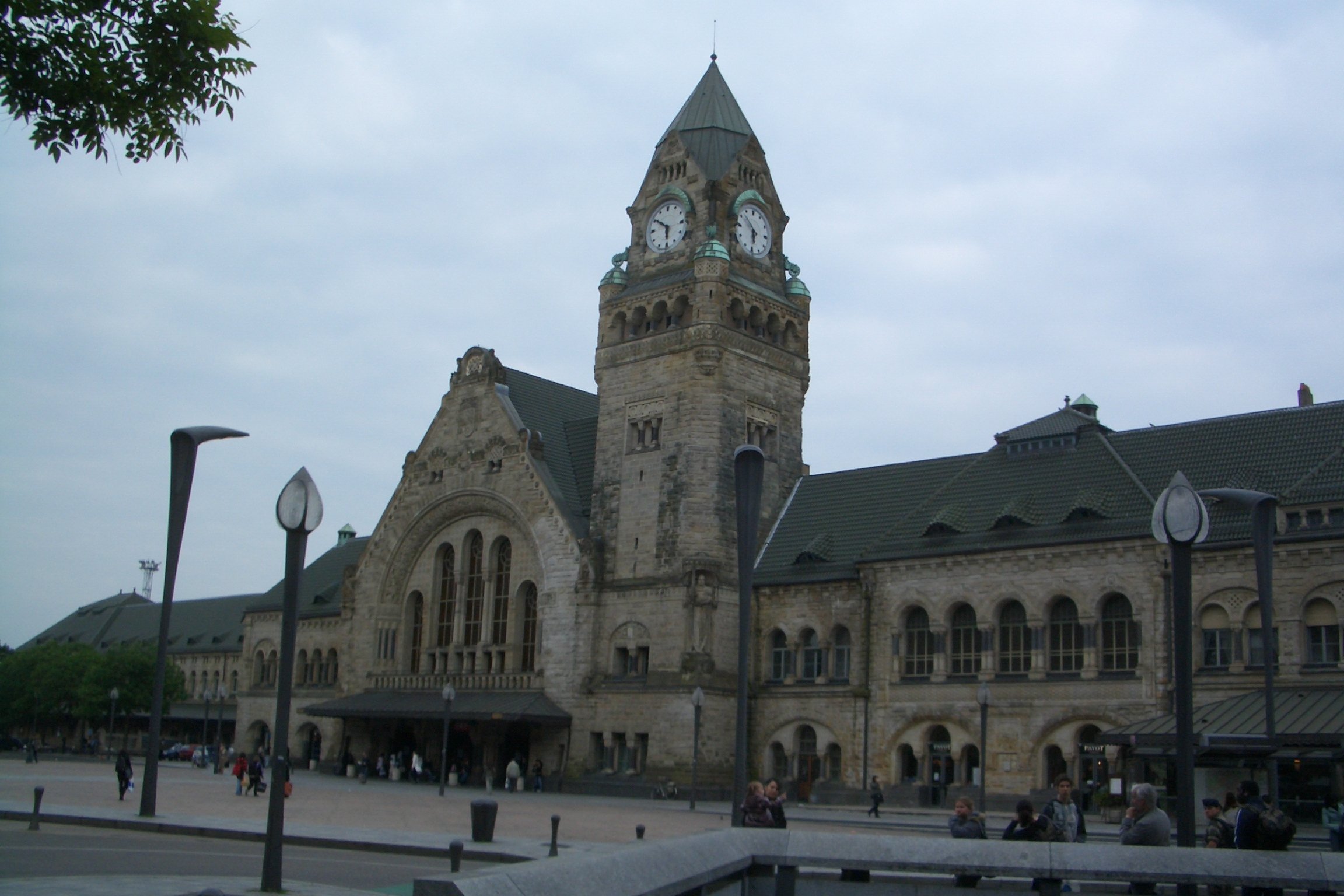
 The railroad station is advertised as a tourist attraction in its own right. It was built by the Germans while this part of Lorraine was under their control (between 1870 and 1918); the central portion and clock tower are intended to seem cathedral-like, and the lower horizontal section (which extends out of the picture to the right) palace-like. The massive post office across the street (behind the camera) is in much the same style but in dark red stone. The whole surface of of both, between actual decorations, is nubbly and reminds me of the texture stonecutters use to represent the wool on lambs. These buildings were intended to reinforce the impression of German presence and power, but documents of the time also establish unambiguously that Germany was already thinking about the next invasion of France. This station is listed as begin built expressly to be able to funnel 100,000 men to the French frontier in 24 hours. (One reason Verdun was chosen as an initial target in WWI is that it was poorly served by road and rail. It's sole line of supply became the road from Bar-le-Duc, 40 km away, still known today as "la voie sacrée," the sacred way. During the months and years of the battle, a truck ran along it, on average, every 14 seconds. When the summer rains turned it muddy, quarries were opened along its whole length, and "territorials," i.e., overage men and the partially disabled, shoveled ton after ton of crushed rock onto it, day in and day out.) In the photo of the station, please note the lampposts, which were designed by some famous French person whose name escapes me. The teardrop-shaped ones just sit there being pretty and light up at night. The left-most one, though, that's bent at a right angle to shine its light down onto the semicircular pedestrian mall in front of the station, is one of a semicircle of similar ones that also dance. The photo at the right is of that self-same lamppost about two minutes later, standing up straight, its light turned off but aimed so as to illuminate the buildings lining the pedestrian mall. I suspect they're light actuated. They were upright when we arrived, but dusk was approaching, and the tops of the lights rotated (around an axis about 45 degrees from the vertical) to the downward position while we watched. But a few minutes later, they changed their minds and stood up again. Perhaps a cloud passed or something.
The railroad station is advertised as a tourist attraction in its own right. It was built by the Germans while this part of Lorraine was under their control (between 1870 and 1918); the central portion and clock tower are intended to seem cathedral-like, and the lower horizontal section (which extends out of the picture to the right) palace-like. The massive post office across the street (behind the camera) is in much the same style but in dark red stone. The whole surface of of both, between actual decorations, is nubbly and reminds me of the texture stonecutters use to represent the wool on lambs. These buildings were intended to reinforce the impression of German presence and power, but documents of the time also establish unambiguously that Germany was already thinking about the next invasion of France. This station is listed as begin built expressly to be able to funnel 100,000 men to the French frontier in 24 hours. (One reason Verdun was chosen as an initial target in WWI is that it was poorly served by road and rail. It's sole line of supply became the road from Bar-le-Duc, 40 km away, still known today as "la voie sacrée," the sacred way. During the months and years of the battle, a truck ran along it, on average, every 14 seconds. When the summer rains turned it muddy, quarries were opened along its whole length, and "territorials," i.e., overage men and the partially disabled, shoveled ton after ton of crushed rock onto it, day in and day out.) In the photo of the station, please note the lampposts, which were designed by some famous French person whose name escapes me. The teardrop-shaped ones just sit there being pretty and light up at night. The left-most one, though, that's bent at a right angle to shine its light down onto the semicircular pedestrian mall in front of the station, is one of a semicircle of similar ones that also dance. The photo at the right is of that self-same lamppost about two minutes later, standing up straight, its light turned off but aimed so as to illuminate the buildings lining the pedestrian mall. I suspect they're light actuated. They were upright when we arrived, but dusk was approaching, and the tops of the lights rotated (around an axis about 45 degrees from the vertical) to the downward position while we watched. But a few minutes later, they changed their minds and stood up again. Perhaps a cloud passed or something.
(written 23 May 2008)
 During our stroll, we also happened on the Brasserie Flo Metz! For Christmas David gave me a lovely coffee-table book about historical French brasseries ("brasserie" means "brewery," and brasseries were originally brew pubs, eateries that brewed their own beer, and they tend, especially the older ones, to serve Alsatian food) that includes not just photos and and narrative about the historical decors, which tend to be gorgeous, but also a little fictional short-short story set in or about each one. A number of them are now Brasserie Flo's, all owned by this guy who goes around France buying up and lovingly restoring historical brasseries. We'd eaten at a number of the ones in Paris, both Flo's and others, and here was our chance to add another to our collection. The one in Metz is strictly Art Deco: brass, chrome, and dark wood, all celebrating the straight line.
During our stroll, we also happened on the Brasserie Flo Metz! For Christmas David gave me a lovely coffee-table book about historical French brasseries ("brasserie" means "brewery," and brasseries were originally brew pubs, eateries that brewed their own beer, and they tend, especially the older ones, to serve Alsatian food) that includes not just photos and and narrative about the historical decors, which tend to be gorgeous, but also a little fictional short-short story set in or about each one. A number of them are now Brasserie Flo's, all owned by this guy who goes around France buying up and lovingly restoring historical brasseries. We'd eaten at a number of the ones in Paris, both Flo's and others, and here was our chance to add another to our collection. The one in Metz is strictly Art Deco: brass, chrome, and dark wood, all celebrating the straight line.
After resting our feet and changing, we set off for our dinner at Le Magazin à Vivres (a Gault-Millau 15/20), which as its name implies, is located in one end of a huge old building left over from the now mostly removed citadel of Metz—the citadel had a powder magazine for storage of ammunition and a supply magazine, le magazin à vivres, for storage of food supplies. The rest of the building is a 4-star hotel called "Le Citadel."
Amuse-bouche, both: Three little dishes containing a foie gras "cromesqui," sort of a croquette (hot and liquid inside), on a bed of diced poached pear; a melon-mint foam over a bed of tiny melon dice and mint chiffonade, flavored with Baume de Venise and sprinkled with toasted coconut; a ball of tomato-basil sorbet on a bed of curried onions.
 First course, both: Cold lobster on a bed of thin slices of melon and striped with two sauces, one herb and one mustard, both creamy. On the side, a variety of crisp baby vegetables: green asparagus, wild asparagus, yellow squash, zucchini, radish slices, cherry tomatoes, carrots, baby leeks, fennel, chervil. The lobster and sauces were excellent, and I really liked the combination with the melon (David doesn't like melon at all). The vegetables were certainly crisp but not otherwise terribly interesting.
First course, both: Cold lobster on a bed of thin slices of melon and striped with two sauces, one herb and one mustard, both creamy. On the side, a variety of crisp baby vegetables: green asparagus, wild asparagus, yellow squash, zucchini, radish slices, cherry tomatoes, carrots, baby leeks, fennel, chervil. The lobster and sauces were excellent, and I really liked the combination with the melon (David doesn't like melon at all). The vegetables were certainly crisp but not otherwise terribly interesting.
Second course, David: A cylinder of local chicken, boned and wrapped around its liver, sliced truffles, and a fluffy, herbal stuffing, then roasted. On the side, more sliced truffles, asparagus, and tiny, tiny new potatoes. Delicious! Served on a slab of marble.
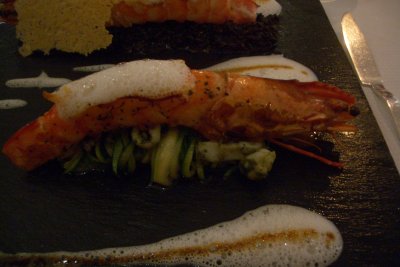 Second course, me: Two roasted "gambas," i.e., really big shrimp (a generous 8 inches from rostrum to telson), one on a bed of shredded braised zucchini mixed with pesto-seasoned squid and the other on a bed of black risotto. Served on a slab of slate. Very good, and amazing to look at.
Second course, me: Two roasted "gambas," i.e., really big shrimp (a generous 8 inches from rostrum to telson), one on a bed of shredded braised zucchini mixed with pesto-seasoned squid and the other on a bed of black risotto. Served on a slab of slate. Very good, and amazing to look at.
Cheese course, David: Morbier, Roquefort, and some sort of very alcoholic cheese marinated in pear liqueur.
Cheese course, me: Pouligny-St.-Pierre, Langres, and Chaource. All very good but all matured very differently from the ones at le Coq Hardi, where the cheeses were liquifying before our eyes. These were quite mature, but much drier, proteolysed but not liquified.
Predessert, both: Gaspacho of strawberries with a milk foam on top. Perfect balance of sweet and tart. Excellent.
 Dessert, both: Lime-poached rhubarb on a bed of hazelnut meringue spread with lime-flavored cream. Sweet wine ice cream on the side. I think the long crisp red strip was a thin slice of rhubarb dipped, or maybe even poached, in sugar syrup and then dried until crisp and fragile as a potato chip.
Dessert, both: Lime-poached rhubarb on a bed of hazelnut meringue spread with lime-flavored cream. Sweet wine ice cream on the side. I think the long crisp red strip was a thin slice of rhubarb dipped, or maybe even poached, in sugar syrup and then dried until crisp and fragile as a potato chip.
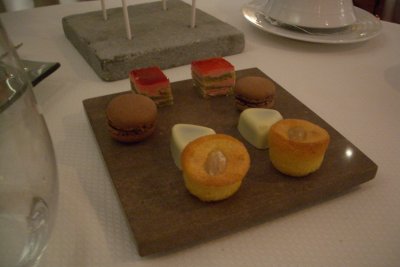 While we ate dessert, they just came and paved the table with mignardises: a square of marble bearing four kinds of petit fours, a square of rough stone perforated with small holes in which stood the sticks of house-made lollypops (white chocolate with dark chocolate chips, what looked like white chocolate with toasted almonds and coconut, a couple different shapes of truffles on a stick), a covered china jar full of house-made marshmallows in an assortment of flavors, a glass dish heaped with two colors of cellophane-wrapped candies (caramels?).
While we ate dessert, they just came and paved the table with mignardises: a square of marble bearing four kinds of petit fours, a square of rough stone perforated with small holes in which stood the sticks of house-made lollypops (white chocolate with dark chocolate chips, what looked like white chocolate with toasted almonds and coconut, a couple different shapes of truffles on a stick), a covered china jar full of house-made marshmallows in an assortment of flavors, a glass dish heaped with two colors of cellophane-wrapped candies (caramels?).
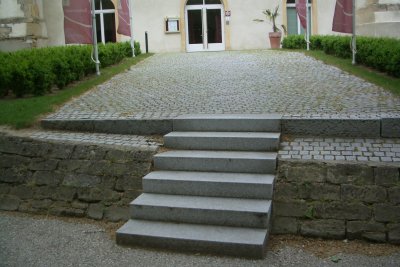 As we left, at the end of the restaurant's walk, we had to descend this little flight of cement steps to the sidewalk. We wonder how many diners, after a bottle or two of wine, perhaps walking abreast and chatting among themselves, arrive at this point (in the dark), take one step down, and then go headlong the remaining three feet to the pavement, having missed the steps to one side or the other.
As we left, at the end of the restaurant's walk, we had to descend this little flight of cement steps to the sidewalk. We wonder how many diners, after a bottle or two of wine, perhaps walking abreast and chatting among themselves, arrive at this point (in the dark), take one step down, and then go headlong the remaining three feet to the pavement, having missed the steps to one side or the other.
previous entry
List of Entries
next entry
Finally, here's an assortment of the wildflowers growing on and around the Fort de Vaux, near Verdun. I'm especially pleased with the one of blue veronica and yellow buttercups because it caught, at the left side, just above the middle, a single strawberry blossom that I hadn't noticed and couldn't actually see as I took the photo.




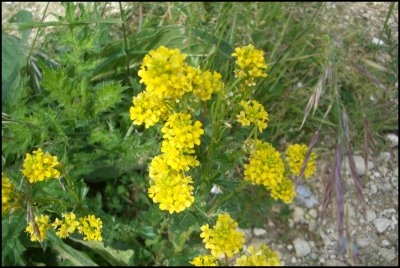
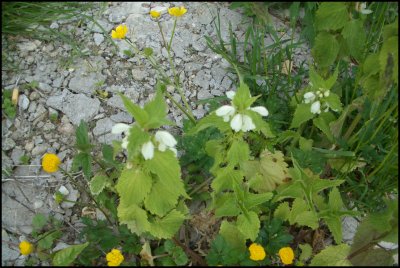



 Next, we tried to visit the Fort de Fermont, one of the largest on the Maginot line, but we found it closed and shuttered. To tour it, we would have to show up at 3 p.m. on the first or third Sunday of the month, so we took a photo of the small blockhouse that guarded its rear approach before continuing our tour. At Longwy, we made our nearest approach to Luxembourg (about 2 km) and began looking for lunch. We finally found some at Le Bar des Supporteurs, i.e., "the (Sports) Fans' Bar," in Ottanges. They had only two kinds of hot sandwiches left, "ciabbatinos" and "hot dogs," so we opted for the former, which were actually delicious: a split baguette toasted, spread with some sort of herb mixture, topped with chopped ham and mild cheese, and run under the broiler. David tried Bofferding, the local beer from Luxembourg, and pronounced it "a pleasant pilsner."
Next, we tried to visit the Fort de Fermont, one of the largest on the Maginot line, but we found it closed and shuttered. To tour it, we would have to show up at 3 p.m. on the first or third Sunday of the month, so we took a photo of the small blockhouse that guarded its rear approach before continuing our tour. At Longwy, we made our nearest approach to Luxembourg (about 2 km) and began looking for lunch. We finally found some at Le Bar des Supporteurs, i.e., "the (Sports) Fans' Bar," in Ottanges. They had only two kinds of hot sandwiches left, "ciabbatinos" and "hot dogs," so we opted for the former, which were actually delicious: a split baguette toasted, spread with some sort of herb mixture, topped with chopped ham and mild cheese, and run under the broiler. David tried Bofferding, the local beer from Luxembourg, and pronounced it "a pleasant pilsner." At our next stop, the Fort de Guentrange (its rear entrance shown here), the story was the same. Guided tours and access to the museum at 3 p.m., second and fourth Sundays from April to November. We hear that some of the forts further east are open more of the time, but we're not sure we'll have time to get to them.
At our next stop, the Fort de Guentrange (its rear entrance shown here), the story was the same. Guided tours and access to the museum at 3 p.m., second and fourth Sundays from April to November. We hear that some of the forts further east are open more of the time, but we're not sure we'll have time to get to them. In Metz, we were booked into the Hotel Royal, on avenue Foch, which looked reasonably easy to find, but we didn't have an "intermediate" map that showed the transition from the highway (on the big regional map) to the city map. Of course, we wound up in the wrong lane and were shunted off our intended route and over a bridge. It took a while, but we bushwhacked our way back and found avenue Foch, complete with little signs directing us to various hotels, but ominously, none of them was for the Hotel Royal. We cruised up the six-block-long avenue and back four times without spotting it, even after narrowing the zone of where it could be by the street number. Finally we just pulled into a side street and parked. David stayed with the car (and quite visible luggage) while I went exploring. Seems it's been chain-ified and is now the Hotel Royal Bleu Marine. We'd seen the big windows marked with the Bleu Marine insignia, all sporting large "to let" signs, but the entrance to the hotel (the only part where the name "Royal" appears) is on the corner of the building, where a side street makes makes an acute angle with the avenue. That facade was facing away from us as we drove by the hotel in one direction and was on the other side of a densely planted median coming the other way. The "to let" signs are advertising for a client to come occupy the hotel's now empty restaurant space.
In Metz, we were booked into the Hotel Royal, on avenue Foch, which looked reasonably easy to find, but we didn't have an "intermediate" map that showed the transition from the highway (on the big regional map) to the city map. Of course, we wound up in the wrong lane and were shunted off our intended route and over a bridge. It took a while, but we bushwhacked our way back and found avenue Foch, complete with little signs directing us to various hotels, but ominously, none of them was for the Hotel Royal. We cruised up the six-block-long avenue and back four times without spotting it, even after narrowing the zone of where it could be by the street number. Finally we just pulled into a side street and parked. David stayed with the car (and quite visible luggage) while I went exploring. Seems it's been chain-ified and is now the Hotel Royal Bleu Marine. We'd seen the big windows marked with the Bleu Marine insignia, all sporting large "to let" signs, but the entrance to the hotel (the only part where the name "Royal" appears) is on the corner of the building, where a side street makes makes an acute angle with the avenue. That facade was facing away from us as we drove by the hotel in one direction and was on the other side of a densely planted median coming the other way. The "to let" signs are advertising for a client to come occupy the hotel's now empty restaurant space.
 The railroad station is advertised as a tourist attraction in its own right. It was built by the Germans while this part of Lorraine was under their control (between 1870 and 1918); the central portion and clock tower are intended to seem cathedral-like, and the lower horizontal section (which extends out of the picture to the right) palace-like. The massive post office across the street (behind the camera) is in much the same style but in dark red stone. The whole surface of of both, between actual decorations, is nubbly and reminds me of the texture stonecutters use to represent the wool on lambs. These buildings were intended to reinforce the impression of German presence and power, but documents of the time also establish unambiguously that Germany was already thinking about the next invasion of France. This station is listed as begin built expressly to be able to funnel 100,000 men to the French frontier in 24 hours. (One reason Verdun was chosen as an initial target in WWI is that it was poorly served by road and rail. It's sole line of supply became the road from Bar-le-Duc, 40 km away, still known today as "la voie sacrée," the sacred way. During the months and years of the battle, a truck ran along it, on average, every 14 seconds. When the summer rains turned it muddy, quarries were opened along its whole length, and "territorials," i.e., overage men and the partially disabled, shoveled ton after ton of crushed rock onto it, day in and day out.) In the photo of the station, please note the lampposts, which were designed by some famous French person whose name escapes me. The teardrop-shaped ones just sit there being pretty and light up at night. The left-most one, though, that's bent at a right angle to shine its light down onto the semicircular pedestrian mall in front of the station, is one of a semicircle of similar ones that also dance. The photo at the right is of that self-same lamppost about two minutes later, standing up straight, its light turned off but aimed so as to illuminate the buildings lining the pedestrian mall. I suspect they're light actuated. They were upright when we arrived, but dusk was approaching, and the tops of the lights rotated (around an axis about 45 degrees from the vertical) to the downward position while we watched. But a few minutes later, they changed their minds and stood up again. Perhaps a cloud passed or something.
The railroad station is advertised as a tourist attraction in its own right. It was built by the Germans while this part of Lorraine was under their control (between 1870 and 1918); the central portion and clock tower are intended to seem cathedral-like, and the lower horizontal section (which extends out of the picture to the right) palace-like. The massive post office across the street (behind the camera) is in much the same style but in dark red stone. The whole surface of of both, between actual decorations, is nubbly and reminds me of the texture stonecutters use to represent the wool on lambs. These buildings were intended to reinforce the impression of German presence and power, but documents of the time also establish unambiguously that Germany was already thinking about the next invasion of France. This station is listed as begin built expressly to be able to funnel 100,000 men to the French frontier in 24 hours. (One reason Verdun was chosen as an initial target in WWI is that it was poorly served by road and rail. It's sole line of supply became the road from Bar-le-Duc, 40 km away, still known today as "la voie sacrée," the sacred way. During the months and years of the battle, a truck ran along it, on average, every 14 seconds. When the summer rains turned it muddy, quarries were opened along its whole length, and "territorials," i.e., overage men and the partially disabled, shoveled ton after ton of crushed rock onto it, day in and day out.) In the photo of the station, please note the lampposts, which were designed by some famous French person whose name escapes me. The teardrop-shaped ones just sit there being pretty and light up at night. The left-most one, though, that's bent at a right angle to shine its light down onto the semicircular pedestrian mall in front of the station, is one of a semicircle of similar ones that also dance. The photo at the right is of that self-same lamppost about two minutes later, standing up straight, its light turned off but aimed so as to illuminate the buildings lining the pedestrian mall. I suspect they're light actuated. They were upright when we arrived, but dusk was approaching, and the tops of the lights rotated (around an axis about 45 degrees from the vertical) to the downward position while we watched. But a few minutes later, they changed their minds and stood up again. Perhaps a cloud passed or something. During our stroll, we also happened on the Brasserie Flo Metz! For Christmas David gave me a lovely coffee-table book about historical French brasseries ("brasserie" means "brewery," and brasseries were originally brew pubs, eateries that brewed their own beer, and they tend, especially the older ones, to serve Alsatian food) that includes not just photos and and narrative about the historical decors, which tend to be gorgeous, but also a little fictional short-short story set in or about each one. A number of them are now Brasserie Flo's, all owned by this guy who goes around France buying up and lovingly restoring historical brasseries. We'd eaten at a number of the ones in Paris, both Flo's and others, and here was our chance to add another to our collection. The one in Metz is strictly Art Deco: brass, chrome, and dark wood, all celebrating the straight line.
During our stroll, we also happened on the Brasserie Flo Metz! For Christmas David gave me a lovely coffee-table book about historical French brasseries ("brasserie" means "brewery," and brasseries were originally brew pubs, eateries that brewed their own beer, and they tend, especially the older ones, to serve Alsatian food) that includes not just photos and and narrative about the historical decors, which tend to be gorgeous, but also a little fictional short-short story set in or about each one. A number of them are now Brasserie Flo's, all owned by this guy who goes around France buying up and lovingly restoring historical brasseries. We'd eaten at a number of the ones in Paris, both Flo's and others, and here was our chance to add another to our collection. The one in Metz is strictly Art Deco: brass, chrome, and dark wood, all celebrating the straight line. First course, both: Cold lobster on a bed of thin slices of melon and striped with two sauces, one herb and one mustard, both creamy. On the side, a variety of crisp baby vegetables: green asparagus, wild asparagus, yellow squash, zucchini, radish slices, cherry tomatoes, carrots, baby leeks, fennel, chervil. The lobster and sauces were excellent, and I really liked the combination with the melon (David doesn't like melon at all). The vegetables were certainly crisp but not otherwise terribly interesting.
First course, both: Cold lobster on a bed of thin slices of melon and striped with two sauces, one herb and one mustard, both creamy. On the side, a variety of crisp baby vegetables: green asparagus, wild asparagus, yellow squash, zucchini, radish slices, cherry tomatoes, carrots, baby leeks, fennel, chervil. The lobster and sauces were excellent, and I really liked the combination with the melon (David doesn't like melon at all). The vegetables were certainly crisp but not otherwise terribly interesting. Second course, me: Two roasted "gambas," i.e., really big shrimp (a generous 8 inches from rostrum to telson), one on a bed of shredded braised zucchini mixed with pesto-seasoned squid and the other on a bed of black risotto. Served on a slab of slate. Very good, and amazing to look at.
Second course, me: Two roasted "gambas," i.e., really big shrimp (a generous 8 inches from rostrum to telson), one on a bed of shredded braised zucchini mixed with pesto-seasoned squid and the other on a bed of black risotto. Served on a slab of slate. Very good, and amazing to look at. Dessert, both: Lime-poached rhubarb on a bed of hazelnut meringue spread with lime-flavored cream. Sweet wine ice cream on the side. I think the long crisp red strip was a thin slice of rhubarb dipped, or maybe even poached, in sugar syrup and then dried until crisp and fragile as a potato chip.
Dessert, both: Lime-poached rhubarb on a bed of hazelnut meringue spread with lime-flavored cream. Sweet wine ice cream on the side. I think the long crisp red strip was a thin slice of rhubarb dipped, or maybe even poached, in sugar syrup and then dried until crisp and fragile as a potato chip. While we ate dessert, they just came and paved the table with mignardises: a square of marble bearing four kinds of petit fours, a square of rough stone perforated with small holes in which stood the sticks of house-made lollypops (white chocolate with dark chocolate chips, what looked like white chocolate with toasted almonds and coconut, a couple different shapes of truffles on a stick), a covered china jar full of house-made marshmallows in an assortment of flavors, a glass dish heaped with two colors of cellophane-wrapped candies (caramels?).
While we ate dessert, they just came and paved the table with mignardises: a square of marble bearing four kinds of petit fours, a square of rough stone perforated with small holes in which stood the sticks of house-made lollypops (white chocolate with dark chocolate chips, what looked like white chocolate with toasted almonds and coconut, a couple different shapes of truffles on a stick), a covered china jar full of house-made marshmallows in an assortment of flavors, a glass dish heaped with two colors of cellophane-wrapped candies (caramels?). As we left, at the end of the restaurant's walk, we had to descend this little flight of cement steps to the sidewalk. We wonder how many diners, after a bottle or two of wine, perhaps walking abreast and chatting among themselves, arrive at this point (in the dark), take one step down, and then go headlong the remaining three feet to the pavement, having missed the steps to one side or the other.
As we left, at the end of the restaurant's walk, we had to descend this little flight of cement steps to the sidewalk. We wonder how many diners, after a bottle or two of wine, perhaps walking abreast and chatting among themselves, arrive at this point (in the dark), take one step down, and then go headlong the remaining three feet to the pavement, having missed the steps to one side or the other.







